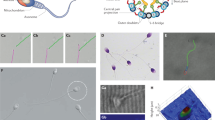Abstract
Successful fertilization only occurs if sperm are able to reach the oviduct and to survive in the female genital tract till ovulation takes place. Cutting-edge imaging technologies such as digital live cell imaging (LCI) and probe-based confocal laser endomicroscopy (pCLE) allow for the first time to visualize sperm transport, fertilization and early embryogenesis under near in vivo conditions, in real-time and on a cellular level. As shown by these novel imaging technologies, the cumulus-oocyte complex firmly attaches to the ampullar epithelium immediately after ovulation initiating a signal cascade leading the sperm to the site of fertilization. Spermatozoa then form a sperm reservoir in the oviduct in which they maintain their fertilizing capacity for 3–4 days in most mammals and humans, for 4 weeks in birds, 6 months in bats and up to 9 years in an Australian snake. In most mammals and mice, sperm bind at a tangential angle to the microvilli of the ciliated cells of the isthmus revealing strong flagellar beating. Binding of the sperm persists till ovulation occurs. Contrary to the human sperm, binding in the oviduct occurs only temporarily (1–90 s). Sperm bind to the microvilli of secretory cells and compete in binding to specific sites. As soon as an oocyte is in the ampulla, spermatozoa get hyperactivated, detach and quickly migrate to the ampulla. Although millions or billions of sperm are inseminated only very few sperm reach the oocyte. After penetration of one sperm, the zona pellucida proteins change the configuration so that no other sperm can get into the oocyte. After fertilization, the presumptive zygote detaches from the ampullar epithelium and migrates down to the uterus.
Access provided by Autonomous University of Puebla. Download conference paper PDF
Similar content being viewed by others
Successful fertilization only occurs if sperm are able to reach the oviduct and to survive in the female genital tract till ovulation takes place. Cutting-edge imaging technologies such as digital live cell imaging (LCI) and probe-based confocal laser endomicroscopy (pCLE) allow for the first time to visualize sperm transport, fertilization and early embryogenesis under near in vivo conditions, in real-time and on a cellular level. As shown by these novel imaging technologies, the cumulus-oocyte complex firmly attaches to the ampullar epithelium immediately after ovulation initiating a signal cascade leading the sperm to the site of fertilization. Spermatozoa then form a sperm reservoir in the oviduct in which they maintain their fertilizing capacity for 3–4 days in most mammals and humans, for 4 weeks in birds, 6 months in bats and up to 9 years in an Australian snake. In most mammals and mice, sperm bind at a tangential angle to the microvilli of the ciliated cells of the isthmus revealing strong flagellar beating. Binding of the sperm persists till ovulation occurs. Contrary to the human sperm, binding in the oviduct occurs only temporarily (1–90 s). Sperm bind to the microvilli of secretory cells and compete in binding to specific sites. As soon as an oocyte is in the ampulla, spermatozoa get hyperactivated, detach and quickly migrate to the ampulla. Although millions or billions of sperm are inseminated only very few sperm reach the oocyte. After penetration of one sperm, the zona pellucida proteins change the configuration so that no other sperm can get into the oocyte. After fertilization, the presumptive zygote detaches from the ampullar epithelium and migrates down to the uterus.
Male subfertility or infertility is often due to a lack of spermatozoa with proper fertilizing capacity. Our novel imaging technologies have shown that spermatozoa that lack fertilizing capability are (a) either not able to bind to the oviductal epithelium or (b) are not able to detach as soon as the oocyte has reached the site of fertilization or (c) are not able to find their way to the oocyte. If sperm are not able to bind to the tubal cells sperm, they will not survive. Alterations of the female genital tract such as inflammation result in sperm being stuck in mucus rendering them unable to detach and reach the oocyte.
In summary, the novel imaging technologies established in the female genital tract allow to analyse physiological behaviour of sperm under near in vivo conditions, in real-time and on a cellular level. In addition to that, these technologies allow us to gain deep insights into the effects of diseases as well as into the actions of medications on sperm transport, formation of the sperm reservoir and fertilization.
Author information
Authors and Affiliations
Corresponding author
Editor information
Editors and Affiliations
Rights and permissions
Copyright information
© 2021 Springer Nature Switzerland AG
About this paper
Cite this paper
Kölle, S. (2021). From Mouse to Human: New Aspects of Sperm Transport and Fertilization Using Cutting-Edge Technologies. In: Björndahl, L., Flanagan, J., Holmberg, R., Kvist, U. (eds) XIIIth International Symposium on Spermatology. Springer, Cham. https://doi.org/10.1007/978-3-030-66292-9_15
Download citation
DOI: https://doi.org/10.1007/978-3-030-66292-9_15
Published:
Publisher Name: Springer, Cham
Print ISBN: 978-3-030-66291-2
Online ISBN: 978-3-030-66292-9
eBook Packages: Biomedical and Life SciencesBiomedical and Life Sciences (R0)




